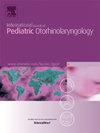Socioeconomic disparities in receipt of cochlear implantation surgery in American children in 2016
IF 1.2
4区 医学
Q3 OTORHINOLARYNGOLOGY
International journal of pediatric otorhinolaryngology
Pub Date : 2025-04-09
DOI:10.1016/j.ijporl.2025.112319
引用次数: 0
Abstract
Objective
This study strives to determine how social determinants of health impact the rate at which pediatric patients receive cochlear implantations.
Methods
The 2016 Kids Inpatient Database was used to determine how different socioeconomic factors statistically impacted the rates of patients receiving cochlear implants. A two-sample independent t-test, univariate, and multivariate regression were used.
Results
Patients with CI surgery were younger and had longer inpatient stays (p < 0.001 & p = 0.017, respectively). Asian/Island Pacific patients were proportionately more likely to receive CI surgery (p = 0.003). Patients visiting hospitals in the South and Midwest regions of America were less likely to receive CI surgery (p < 0.001 & p = 0.004, respectively). Patients in the West and Northeast were more likely to receive implantation (p = 0.019).
Conclusion
Black and Hispanic children were the least likely to receive implantation, while white and Asian children were more likely to receive them. Patients in the South and Midwest were noted to be less likely to receive implantation. To enhance the quality and efficiency of care, it is necessary to identify and address these disparities to achieve more equitable healthcare for pediatric sensorineural hearing loss patients.
2016年美国儿童接受人工耳蜗植入手术的社会经济差异
目的本研究旨在确定健康的社会决定因素如何影响儿童患者接受人工耳蜗植入术的比率。方法利用2016年儿童住院患者数据库,确定不同社会经济因素对人工耳蜗植入率的影响。采用两样本独立t检验、单变量和多变量回归。结果CI手术患者年龄较小,住院时间较长(p <;0.001,P = 0.017)。亚洲/太平洋岛国患者接受CI手术的比例更高(p = 0.003)。在美国南部和中西部地区就诊的患者接受CI手术的可能性较小(p <;0.001,P = 0.004)。西部和东北部患者更容易植入(p = 0.019)。结论黑人和西班牙裔儿童接受植入的可能性最低,白人和亚裔儿童接受植入的可能性较高。南部和中西部的患者接受植入的可能性较小。为了提高护理的质量和效率,有必要识别和解决这些差异,以实现对儿童感音神经性听力损失患者更公平的医疗保健。
本文章由计算机程序翻译,如有差异,请以英文原文为准。
求助全文
约1分钟内获得全文
求助全文
来源期刊
CiteScore
3.20
自引率
6.70%
发文量
276
审稿时长
62 days
期刊介绍:
The purpose of the International Journal of Pediatric Otorhinolaryngology is to concentrate and disseminate information concerning prevention, cure and care of otorhinolaryngological disorders in infants and children due to developmental, degenerative, infectious, neoplastic, traumatic, social, psychiatric and economic causes. The Journal provides a medium for clinical and basic contributions in all of the areas of pediatric otorhinolaryngology. This includes medical and surgical otology, bronchoesophagology, laryngology, rhinology, diseases of the head and neck, and disorders of communication, including voice, speech and language disorders.

 求助内容:
求助内容: 应助结果提醒方式:
应助结果提醒方式:


